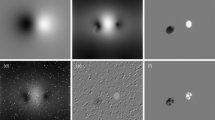Abstract
Semel and Skumanich proposed a method to obtain the absolute electric current density, |J z |, without disambiguation of 180° in the transverse field directions. The advantage of the method is that the uncertainty in the determination of the ambiguity in the magnetic azimuth is removed. Here, we investigate the limits of the calculation when applied to a numerical MHD model. We have found that the combination of changes in the magnetic azimuth with vanishing horizontal field component leads to errors, where electric current densities are often strong. Where errors occur, the calculation gives |J z | too small by factors typically 1.2–2.0.
Similar content being viewed by others
References
Deloach A C, Hagyard M J, Rabin D, et al. Photospheric electric current and transition region brightness within an active region. Sol Phys, 1984, 91: 235–242
Lin Y, Gaizauskas V. Coincidence between Halpha flare kernels and peaks of observed longitudinal electric current densities. Sol Phys, 1987, 109: 81–90
Hagyard M J. Observed nonpotential magnetic fields and the inferred flow of electric currents at a location of repeated flaring. Sol Phys, 1988, 115: 107–124
Canfield R C, Hudson H S, Leka K D, et al. The X flare of 1991 November 15 — Coordinated Mees/Yohkoh observations. Publ Astron Soc Jpn, 1992, 44: L111–115
Leka K D, Canfield R C, McClymont A N, et al. The morphology of flare phenomena, magnetic fields, and electric currents in active regions. II — NOAA active region 5747 (1989 October). Astrophys J, 1993, 411: 370–377
de La Beaujardiere J -F, Canfield R C, Leka K D. The morphology of flare phenomena, magnetic fields, and electric currents in active regions. III — NOAA active region 6233 (1990 August). Astrophys J, 1993, 411: 378–382
Zhang H, Wang T. Vertical current and a 3B/X12 flare in a highly sheared active region (NOAA 6659) on June 9, 1991. Sol Phys, 1994, 151: 129–136
Wu S T, Weng F S, Wang H M, et al. Magnetic structures and energy of 1989 March flares. Adv Space Res, 1993, 13: 127–130
van Driel-Gesztelyi L, Hofmann A, Demoulin P, et al. Relationship between electric currents, photospheric motions, chromospheric activity, and magnetic field topology. Sol Phys, 1994, 149: 309–330
Metcalf T R, Canfield R C, Hudson H S, et al. Electric currents and coronal heating in NOAA active region 6952. Astrophys J, 1994, 428: 860–866
Gary G A, Demoulin P. Reduction, analysis, and properties of electric current systems in solar active regions. Astrophys J, 1995, 445: 982–998
Li J, Metcalf T R, Canfield R C, et al. What is the spatial relationship between hard X-ray footpoints and vertical electric currents in solar flares? Astrophys J, 1997, 482: 490–497
Burnette A B, Canfield R C, Pevtsov A A. Photospheric and coronal currents in solar active regions. Astrophys J, 2004, 606: 565–570
Gary A, Moore R L. Eruption of a multiple-turn helical magnetic flux tube in a large flare: Evidence for external and internal reconnection that fits the breakout model of solar magnetic eruptions. Astrophys J, 2004, 611: 545–556
Gao Y, Xu H, Zhang H. Probing the method of correcting Faraday rotation in vector magnetograms. Adv Space Res, 2008, 42: 888–894
Semel M, Skumanich A. An ambiguity-free determination of J-Z in solar active regions. Astron Astrophys, 1998, 331: 383–383
Li J, van Ballegooijen A, Mickey D. Vector magnetic fields and electric currents from the imaging vector magnetograph. Astrophys J, 2009, 692: 1543–1560
Li J, Mickey D L, LaBonte B J. The X3 Flare of 2002 July 15. Astrophys J, 2005, 620: 1092–1100
Cowling T G. The electrical conductivity of an ionized gas in a magnetic field, with applications to the solar atmosphere and the ionosphere. R Soc Lond Proc Ser A, 1945, 183: 453–479
Fan Y, Gibson S E. The emergence of a twisted magnetic flux tube into a preexisting coronal arcade. Astrophys J Lett, 2003, 589: L105–108
Fan Y, Gibson S E. Numerical simulations of three-dimensional coronal magnetic fields resulting from the emergence of twisted magnetic flux tubes. Astrophys J, 2004, 609: 1123–1133
Author information
Authors and Affiliations
Corresponding author
Rights and permissions
About this article
Cite this article
Li, J., Fan, Y. Limitations of absolute current densities derived from the Semel & Skumanich method. Sci. China Ser. G-Phys. Mech. Astron. 52, 1678–1685 (2009). https://doi.org/10.1007/s11433-009-0272-1
Received:
Accepted:
Published:
Issue Date:
DOI: https://doi.org/10.1007/s11433-009-0272-1



